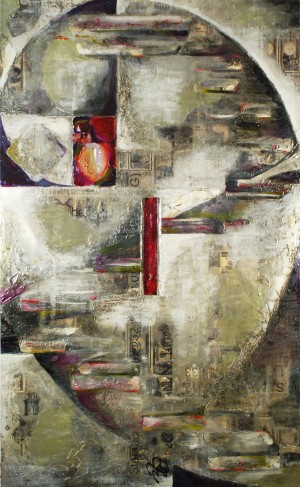Barry Boneau: The Emergent, Progressive Artist
With a philosophy steeped in the evolution of mankind, artist Barry Boneau has added to his collection a series of Phi divine, proportion-inspired works, which blend both human conscious with perfect mathematics.
Barry Boneau is everything you would expect in an artist. His distinguishable works hang in Upper East Side lounges such as Aza and Lexington Social and have been showcased at New York’s finest art shows. He wears knitted hats and designer sunglasses, sips midday glasses of white wine, and has an apartment overlooking the Upper East Side which is always filled with natural light.
As an artist, he is also the completely unexpected. In the ever-evolving art realm, he is a Renaissance man shedding new light (and oil colors) on an ancient concept.
A mathematician, philosopher, and very soon-to-be father, as well as an architect and interior designer, Boneau, age 38, has been producing canvas-creations practically dripping with mathematically devised designs, alive with bold color and raw texture.
“It’s sort of an ongoing concept that is evolving,” Boneau explains, displaying his large, abstract canvases that hang or lean against every wall of his apartment. The concept begins with Phi, the golden ration of a rectangle. It is believed to be the same equation Egyptians used for their pyramids and the Greeks used for the Parthenon. In the Renaissance, the mathematical equation exploded. An Italian mathematician of the Middle Ages named Leonardo Pisano Bigollo (also known as Leonardo Fibonacci) presented the theory of Fibonaccian spirals. These spirals exist throughout all of nature– twisters, galaxies, seashells, sunflowers, and “even the water in the toilet bowl!” explains Boneau, who was first introduced to Fibonacci during his architecture college studies.
In the Fibonaccian sequence, numbers are added together, beginning with 0 and 1. The subsequent numbers are always the sum of the previous two (0, 1, 1, 2, 3, 5, 8, 13…). When squares are tiled and their sides’ lengths mimic this pattern, a spiraling effect can be observed. Boneau’s art portrays exactly that aesthetic, the “evolution of things expanding.” Taking this idea, he layers it in shimmering color on canvas.
“I like to layer as many ideas on top of a concept as I can. This concept has so many layers already — the Renaissance, the Greeks, even the stock market. It’s seen over and over again,” he says.
But never has an artist approached the Phi number like this.
His canvas either starts as a perfect square (the origin of Phi) or he begins with a perfect square block within the canvas, and spirals backward. Each time, the painting is left with a perfect square at the center of the spiral. This he hollows out, adding another dimension to his work. For him, the hollow represents an infinity that mimics human evolution, it just goes on forever.
“I approach paintings in the way I approach design,” confesses Boneau. “It’s a solution. In painting, I set up my own rules. What’s beautiful about creating pieces of artwork is that you create your own rules and boundaries, instead of being given rules. This (Phi) is where I made up my own rules. If you don’t have boundaries, you get lost and you have nothing to hold on to.”
For Boneau, this idea of boundaries has continuously impacted his life.
A native to the Midwest, he describes growing up without much diversity or exposure to new ideas, bound to a conservative way of life. He received his undergraduate degree in architecture from the University of Missouri and went on to receive a Masters of Architecture at the University of Kansas. It was there that he took his first painting course.
“They didn’t let me take the class at first,” he laughs. “I needed a certain level of credit to take it. But I spoke to the teacher, she was from New York, and she found a solution,” a new idea within the rules, taking him on as a private study student. “She taught me how to mix color…then just let me go.” Here, he found his freedom. He had always been scolded for doodling on walls as a child but his potential went unrecognized. Finally, he was allowed to create whatever he wanted, instead of what was demanded.
However, caught up in seeking what was dubbed a more lofty career, it would not be until several years later that he would even consider becoming an artist.
“I was gonna be an architect,” he explains. He graduated his prestigious program and went back to work in Chicago as an architect.
“This is when painting became a real freedom for me. Architecture is not as romantic as they make it seem in the movies. It’s only about 10 percent [centered on] design and the rest is nuts and bolts,” he says.
After a long haul of frustration, he left his high paying architect job in Chicago and went on to design kitchens and bathrooms. When that did not work, he switched business endeavors totally and worked in a restaurant while building furniture on the side.
(Article continued on next page)

